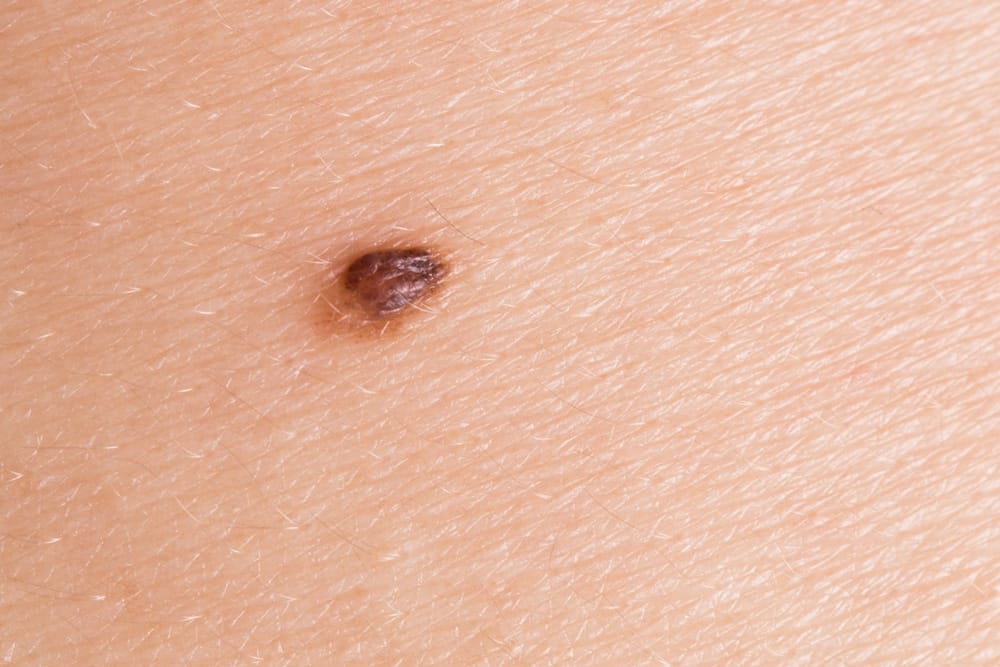Un « grain de beauté » ou nævus est constitué à partir des mélanocytes, cellules produisant le pigment responsable du bronzage de la peau, qui se mettent à se développer en perdant tout contrôle et de manière anarchique.
Les grains de beauté ou naevus sont habituellement bénins, sans danger. Ils peuvent néanmoins évoluer et dégénérer en donnant un mélanome, qui est un cancer de la peau dont le pronostic peut être sévère. Le mélanome peut se développer de manière insidieuse et revêtir au début l’aspect d’un grain de beauté banal.
C’est une des raisons pour lesquelles faire examiner ses grains de beauté par un dermatologue est une nécessité et une démarche responsable pour mieux gérer sa santé.Le grain de beauté classique est à différencier des mélanoses circonscrites, qui sont des pigmentations liées à un hyperfonctionnement des mélanocytes : masque de grossesse ou tache café au lait de naissance par exemple.

Bilan personnalisé
Afin de déterminer le soin le plus adapté, une première consultation est préconisée.
L'objectif est d'analyser vos besoins et d'établir un plan de traitement sur-mesure.
Quelles solutions pour traiter vos grains de beauté à la Clinique du Lac ?
Certains grains de beauté sont des anomalies congénitales, visibles le jour de la naissance, d’autres sont des lésions acquises plus tard dans le courant de la vie.
Un grain de beauté peut revêtir des aspects multiples : plat, en relief, parsemé de poils ou glabre (sans poil).Sa couleur est très variable : pâle presque blanc, rosé, marron clair ou foncé, voire très noir.Un grain de beauté peut parfois présenter une gène esthétique ou être douloureux s’il est placé sur une zone de frottements. Une petite intervention chirurgicale peut alors être proposée pour le retirer.
La Clinique du Lac peut vous proposer une exérèse chirurgicale, il faut tout d’abord rencontrer le chirurgien esthétique lors d’une première consultation puis l’intervention pourra être programmée. Cette intervention dure entre 30 et 45 mins et ne nécessite pas d’anesthésie générale ni d’arrêt de travail.
L’ablation peut aussi se faire grâce au laser CO2 proposé par la Clinique du Lac, le praticien vous orientera vers l’une ou l’autre méthode selon l’aspect et la taille de votre naevus. La technique par laser offre des suites très simples.
Laser grains de beauté (Naevus)
Un grain de beauté inesthétique peut être retiré pratiquement sans cicatrice par la technique du laser CO2 fractionné. Avec une simple anesthésie locale, le ou les grains de beauté sont vaporisés par le laser CO2.Le médecin s’assure que le grain de beauté ne présente pas de risque de cancer de la peau.Après disparition de la petite croûte, ne persiste qu’une discrète rougeur pendant quelques semaines.L’avantage du laser : éviter une exérèse chirurgicale qui laisse une cicatrice plus ou moins importante.Un grain de beauté ou nævus est un amas de cellules pigmentaires qui peut se situer sur la peau du visage ou du corps, chez les hommes comme chez les femmes. La teinte d’un grain de beauté peut être plus ou moins foncée et sa forme est généralement ronde ou ovale. Certains grains de beauté sont plats, d’autres en relief, ils ne sont pas douloureux.
Un grain de beauté pouvant évoluer en cancer de la peau (mélanome), il présente un risque pour la santé. Il est donc recommandé de surveiller régulièrement vos grains de beauté et de les faire examiner par un dermatologue en cas d’évolution suspecte.
Un grain de beauté ou nævus est un amas de cellules pigmentaires qui peut se situer sur la peau du visage ou du corps, chez les hommes comme chez les femmes. La teinte d’un grain de beauté peut être plus ou moins foncée et sa forme est généralement ronde ou ovale. Certains grains de beauté sont plats, d’autres en relief, ils ne sont pas douloureux.
Un grain de beauté pouvant évoluer en cancer de la peau (mélanome), il présente un risque pour la santé. Il est donc recommandé de surveiller régulièrement vos grains de beauté et de les faire examiner par un dermatologue en cas d’évolution suspecte.
200 € la séance pour l’ablation d’un naevus
100 € par grain de beauté supplémentaire au cours de la même séance (maximum 10).
Enlever un grain de beauté avec le laser CO2
Enlever un grain de beauté au laser est rapide et peu douloureux. Une anesthésie locale peut cependant vous être proposée. Le faisceau laser est dirigé sur le grain de beauté pour détruire les cellules responsables de sa pigmentation. Une petite croûte se forme puis tombe au cours des jours qui suivent le traitement. Une légère rougeur peut persister durant quelques mois, elle s’estompe peu à peu. Protégez la zone avec une crème en cas d’exposition au soleil.
Le traitement au laser CO2 fractionné présente l’avantage de ne pas laisser de cicatrices, contrairement à la chirurgie. Cette technique est déjà utilisée en médecine esthétique pour lutter contre les rides ou les vergetures. Elle peut aussi être utilisée pour traiter une cicatrice chéloïde ou encore les traces laissées par l’acné sur votre peau et les lésions cutanées .
Contactez la Clinique du Lac pour vérifier si vos nævus peuvent faire l’objet d’un traitement au laser fractionné.
